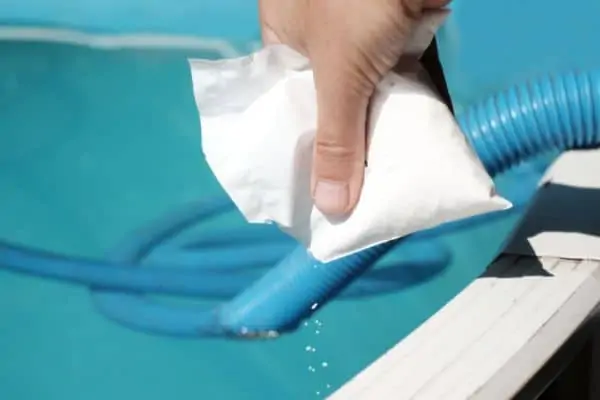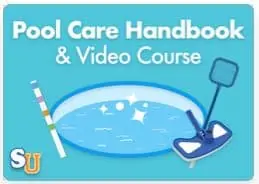When to use pool shock falls into two separate sections: under what circumstances most pool owners should shock a pool and, if it needs to be shocked, what is the best time of day to carry out the shock.
In addition to regular pool shocks, you will need to shock the pool when opening it, when the weather is extremely hot, when it has rained heavily, if you have an algae attack or if the combined chlorine level is high.
A pool owner must understand many intricate things about shocking a swimming pool. To always have a clean pool, you need to understand why a pool needs to be shocked and do it correctly each time.

When to add pool shock?
For regular maintenance, pools should be shocked once every one to two weeks, but this depends on the water’s clarity and how much use the pool gets.
However, there are other times when shock chlorine pools outside of scheduled maintenance are a good idea.
Here are a few other scenarios where you might find it a good idea to shock your pool:
1. Opening up in spring
When you open your pool for the swimming season, spring algae has a chance to start propagating quickly with rising temperatures and exposure to sunlight. Shocking the pool with chemicals at this point can help prevent a lot of hassle and clean-up later.
2. After heavy use
If a large number of active swimmers use the pool, perhaps after a pool party, it can cause a drop in chlorine levels and the introduction of bacteria that can make the pool dirty. Shocking after-parties can help bring the pool’s pH levels back to baseline and help sanitize it after heavy use.
Many people using it can mean that oils, creams, and other products are brought into your pool water. Using chlorinated shock will help eliminate these and make the water safe for swimming again.
3. Going on vacation
If you go on vacation for extended periods, giving your pool a good dose of unstabilized chlorine shock immediately before you go will help prevent you from returning home to a nasty swimming pool.
4. Reducing Chloramines
Shocking is also good if swimmers find their eyes and skin irritated by chloramines, which build up in the water as chlorine binds with ammonia-based contaminants like sweat and urine to form combined chlorine.
Once combined with other contaminants, the chlorine is no longer free to deal with other bacteria etc (Source: Center for Disease Control)
Many swimmers mistakenly associate a strong chlorine smell or burning eyes with excess chlorine in the pool. Still, as stated, there is no free chlorine, only combined chlorine.
A strong chlorine smell in pool water and eye irritation results from the chloramines in the water, not the chlorine. Adding additional chlorine to the water in the form of pool shock helps to reduce the smell and effects of chloramines and gives higher free chlorine levels. Adding non-chlorine shock will not fix this.
5. After heavy rain
Rain can change the pH levels of a pool while also introducing organic contaminants that encourage the growth of algae and bacteria.
Shocking the pool after rain can prevent the pool from turning green after heavy rains.
6. During periods of dry, hot weather
Hot, sunny weather raises the pool water temperature, making it a more favorable environment for algae and bacteria. Flushing the pool with fresh cold water lowers the warm water temperature and shocking it can prevent the pool water from looking cloudy.
Shocking a pool Outside regular maintenance is an excellent preventative measure whenever environmental factors increase the risks of bacteria and algae growth or disrupt the pool’s pH levels.
7. Extreme algae growth
The most effective way to fight an algae attack is to use pool shock to increase the pool’s chlorine level significantly (known as super-chlorinating). If the attack is serious, you may have to do this a number of times.
Algaecides are generally used as a preventative measure rather than a way to deal with such an attack.
8. Unstable chlorine levels
If your chlorine levels never stand still, being too high one day and too low the next, a shock treatment may be needed. This shock will release most of the combined chlorine in your pool while re-balancing everything to allow the chemicals you have added to do their work efficiently.
Always test the pool’s water with a good test kit and shock if necessary.
It is essential to understand the difference between free chlorine, total chlorine and the combined chlorine level, so I suggest you also read my post – Free chlorine vs total chlorine vs combined chlorine explained
Also read: How often should you shock your pool
The best time of day to shock pool
If you shock a pool in the morning or during the day, ultraviolet sunlight reduces the effectiveness of chlorine and causes it to dissipate very quickly before it has a chance to work.
The best time of day to shock your pool is in the evening after the sun is down. This allows the pool chlorine time to spread out in the water and clean it before daytime temperatures reduce the effectiveness of the shock and dissipate it.
Shocking the pool in the evening also allows you to run the pool pump overnight to help distribute the shock around the pool. This means that the pool will probably be safe to swim after being shocked again the following day.
You should test the free chlorine levels to ensure they have reduced enough to allow swimmers to return to the pool.
My article Can I swim 12 hours after shocking pool explains this in more detail.

How to Shock a Pool
Now that you know under what circumstances you should shock your pool, this is a quick guide to how to do it.
The process of shocking your pool will soon become a habit that you can easily do.
Shocking your pool involves a few easy steps to follow:
1. Test the water
You should be testing the water every day with a strip anyway, but before shocking, we need to know the levels of the pool chemicals. Doing a full test with all the required chemicals will allow you to know exactly what to add.
2. Adding chemicals
Depending on the chemical readings you have just taken, you will know what chemicals you should add to the pool. It may require adding acid if the pH is high or adding baking soda or soda ash if the pH is too low before adding shock. Hopefully, it will not require anything at all. Whatever it is, the chemicals must be balanced before shocking.
3. Wait until sunset
The most important part about adding a shock treatment to your pool is ensuring the sun cannot destroy the chlorine. We recommend adding a shock treatment just after sunset when the pool will no longer be hit by the sun.
4. Add the shock
Depending on the type of shock (read the label), you can either add it directly into the pool or mix it in a bucket filled with water before adding it. I always walk around the side of the pool adding a little as I go to ensure it is distributed as thoroughly as possible.
IMPORTANT: Whatever you do, if mixing the shock and water in a bucket, always fill the bucket with water first and then add the shock to the water. Never add the shock first and then add water.
5. Run the pump overnight
This is one of the main reasons I leave it until the evening to shock my pool. I can then set the pool pump to run overnight to thoroughly mix the shock and allow it to do its “magic” when the sun isn’t shining.
The bonus is that swimming after shocking the pool might be able to recommence the next day if the chlorine readings are safe.
6. Test again
Once everything has mixed in and the recommended time on the back of the shock treatment kit has passed, you must test the water again.
If everything is correct, such as the chlorine level and the pH, then that is it – job done.
If not, you may need to shock again, and this may also be the case if you add shock to kill algae but the pool water is still green.
Conclusion
Shocking swimming pools is a normal part of keeping them clean throughout the year. It also helps eliminate algae growth. Make sure you always have shock ready to use, as you may need to do it at any time to keep the pool sparkling.






Leave a Reply